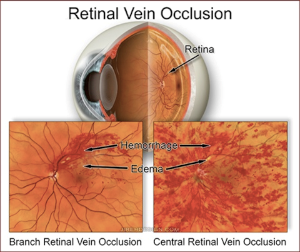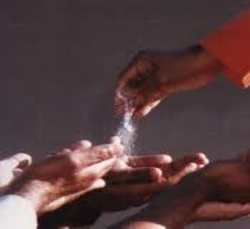Central Retinal Vein Occlusion 02867...USA
An 83-year-old female patient reported to the practitioner with an eye condition known as "central retinal vein occlusion," (CRVO) in her right eye. When the central retinal vein is blocked, the circulation through the retina is decreased, swelling occurs,  and often accumulation of fluid in that area is also increased. This patient's vision was notably impaired, and was described as black spots in certain areas of her line of vision, hence suffering from partial blindness. Sometimes, pain of pressure was noted. When she initially presented herself to the ophthalmologist, the physician diagnosed her with the above condition and submitted her to an ongoing series of injections in the eyeball every 4-5 weeks to release the pressure behind the eye. She also went for a general check-up to verify her blood pressure and other possible cardio- vascular conditions, all of which came back negative.
and often accumulation of fluid in that area is also increased. This patient's vision was notably impaired, and was described as black spots in certain areas of her line of vision, hence suffering from partial blindness. Sometimes, pain of pressure was noted. When she initially presented herself to the ophthalmologist, the physician diagnosed her with the above condition and submitted her to an ongoing series of injections in the eyeball every 4-5 weeks to release the pressure behind the eye. She also went for a general check-up to verify her blood pressure and other possible cardio- vascular conditions, all of which came back negative.
The prognosis for this condition varies according to the patient, and so treatment duration also varies. However, if damage in vision has occurred, and doesn't change rapidly after the onset of treatment, the chances of regaining eyesight are not likely. And after two and half years treatment, the patient still went every 4 weeks because the fluid build-up and pressure in the eye were equally intense and, with no eyesight improvement. The doctor said that she might have to continue those treatments indefinitely.
It is important to note that the overall health of this patient is remarkably excellent. No major illness in the past, very few common colds, some hearing impairment. However, around the time of the onset of CRVO, she had moved from Europe to the United States and was tired and moderately stressed by the transition.
When she came for vibrionics treatment (10/25/2012), she was given an oral remedy as well as drops to administer in her eyes. Initially, the oral combo was as follows:
#1. CC7.2 Partial Vision + CC12.1 Adult tonic + CC15.1 Mental & Emotional tonic…TDS for 3 weeks.
On 11/10, CC15.1 Mental & Emotional Tonic was replaced by CC7.6 Eye Injury… 6TD for 4 months, then QDS 6 months.
The eye-drop combo was water based and the cards used were:
NM17 Eye 200C + NM113 Inflammation 30X + BR2 Blood Sugar 200C + BR18 Circulation + BR20 Eye 200C
The patient returned to her ophthalmologist 3 weeks after starting vibrionics treatment. For the first time in two and half years, there was a significant 30% change in the condition of the eye, when seen on the X-rays, the swelling had dramatically dropped and so had the amount of fluid behind the eyeball.
Though she was given an injection, she was instructed to extend the interval time until her next appointment from the usual 4 weeks to 6 weeks. And so she did. The weeks passed and as she continued her regimented vibrionics schedule, she felt very little pressure in her eye; she even reported seeing better as well by 40%. For two more six-week interval ophthalmologist visits, she received eye injections. But the doctor said that there was an even more significant improvement in her overall condition; about 50%.
And the following visit, both the X-rays and an improved vision test lead her to skip her injection altogether. The improved vision was most remarkable, as this is not considered possible at this stage of the condition, because the damaged cells are said to be "dead". She went once more and there was very little swelling though they did another injection.
The timing of vibrionics treatment and her improvement are very telling. Regarding the point of timing, something else happened; the patient took a fall and broke her left wrist, for which she needed a cast for 6 weeks. It rendered taking the vibrionics remedies impossible due to poor dexterity and a cast. On the following appointment to the ophthalmologist, two to three weeks after the fracture, she went for her eye exam. The swelling and pressure had returned and so she needed her injection again.
So while the CRVO condition is not entirely gone, it has responded dramatically to the vibrionics treatments, improving when she takes them, and worsening when she doesn't. When the cast came off she resumed her vibrionics remedy 6TD. Three weeks later on her next visit, the doctor did not administer another injection and re-scheduled a visit for another five weeks, which would be a total of ten weeks, the longest interval between injections since the onset of her ailment. As of December 2013, she was increasing the interval time between her injections every time she went to the ophthalmologist by 8 to 10 weeks. Both treatments continue simultaneously.
